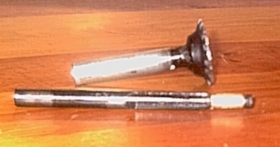Hi, The title pretty well defines the subject I have in mind. On another thread "Reaming 357 mag Throat, and 357 Max throat" I laid out a possible way to change a 357 mag to a 357 max with a throater and a chucking reamer.
I also have several projects with other straight walled tapered cartridges where I am planning to either just use a factory plain chucking reamer or taper pin reamer and /or in conjunction with each other to make 25 Hornet chambers, 30 Carbine chambers, and .22 CCM variant (with .020" taper) chambers. I wanted to throw out this subject and see what you other guys with expertise in this area think.
For chamber necks or the body of a straight-357Max type case an oversize chucking reamer could be reduced in size with a tool post grinder and polished to produce a non-cutting body, and a non cutting pilot section (or even sleeved pilot) with a gap between, and the front edges of the full diameter flutes behind the gap sharpened to cut either a case mouth vertical shoulder, or any type of taper.
I am also interested in the idea of making taper pin reamers with a pilot by this method to use as forcing cone reamers for revolter barrels. I know the angle is somewhat slight as stock, but the appropriate section of the reamer could be made steeper and resharpened. How slight of an angle would work well, does anyone know? I guess this could also be done with a chucking reamer.

|
   
   
|


|




 Reply With Quote
Reply With Quote

















